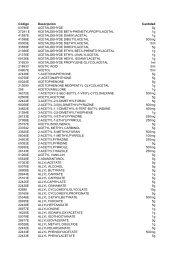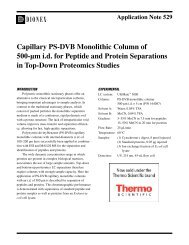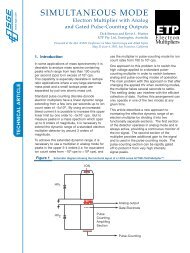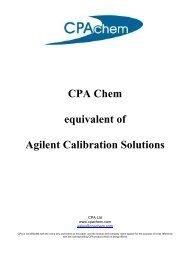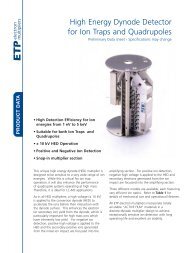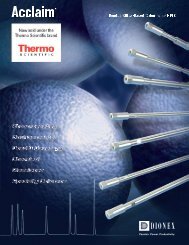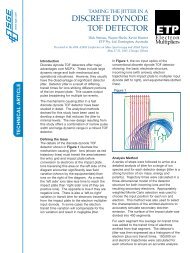Accucore HPLC Columns - Cromlab
Accucore HPLC Columns - Cromlab
Accucore HPLC Columns - Cromlab
You also want an ePaper? Increase the reach of your titles
YUMPU automatically turns print PDFs into web optimized ePapers that Google loves.
Instrument Optimization<br />
<strong>Accucore</strong> <strong>HPLC</strong> columns produce very narrow<br />
Instrument<br />
peaks. In order<br />
Optimization<br />
to preserve this efficiency<br />
the <strong>HPLC</strong> system should be optimized to reduce any potential causes of peak broadening.<br />
Potential causes of peak broadening are:<br />
Potential causes of peak broadening are:<br />
Extra-column band broadening<br />
Extra-column band broadening<br />
The following equation for extra-column broadening shows that it is important to limit injection<br />
volume, minimize flow cell volume and make The following sure that equation short, narrow for extra-column ID tubing is broadening used. shows that it is important to limit injection<br />
volume, minimize flow cell volume and make sure that short, narrow ID tubing is used<br />
Tubing radius<br />
K Constant<br />
V inj Injection volume<br />
V cell Flow cell volume<br />
F Flow rate<br />
r c<br />
l c<br />
Tubing length<br />
D m Diffusion coefficient<br />
in mobile phase<br />
Page 14<br />
<strong>Accucore</strong> columns produce very narrow peaks. In order to preserve this efficiency the <strong>HPLC</strong> syst<br />
should be optimized to reduce any potential causes of peak broadening.<br />
Constant<br />
Injection volume<br />
Flow cell volume<br />
Flow rate<br />
Tubing radius<br />
Tubing length<br />
Diffusion coefficient in mobile phase<br />
Slow detector response<br />
The detector time constant or sampling rate must be optimized for narrow peaks.<br />
If this is not done then losses in intensity and increases in peak width are seen.<br />
Data Peak width Peak Peak height<br />
Slow detector point* 4σ response (s) area (mAu)<br />
The 1 Hz detector 2 time 2.04 constant 246330 or 107.4 sampling rate<br />
must 5 Hz be 6optimized 0.96 for 57244 narrow 118.4 peaks. Is this is<br />
not 10 Hzdone 10 then 0.87 losses in 55750 intensity 114.5 and increases in<br />
peak 20 Hz width 18 are 0.87 seen. 55319 115.4<br />
* Number of data points are collected over 4σ<br />
1 Hz<br />
5 Hz<br />
10 Hz<br />
20 Hz<br />
Octanophenone<br />
RT: 0.87 – 0.93<br />
0.87 0.88 0.89 0.90 0.91 0.92 0.93<br />
Minutes<br />
Fast gradients<br />
For fast gradients it is also important to minimize the pump dwell volume to ensure<br />
that the gradient reaches the column as quickly as possible.<br />
Gradient<br />
arrives 1.45 min<br />
0.0 1.0 2.0 3.0 4.0 5.0<br />
Minutes<br />
Fast Gradients<br />
For fast gradients it is also important to minimize Column: fully porous < 2 µm,<br />
50 x 2.1 mm<br />
Pump dwell volume the dwell volume to ensure that the gradient<br />
Mobile phase A: water + 0.1% formic acid<br />
800µL reaches 80µL the column as quickly as possible.<br />
Mobile phase B: acetonitrile + 0.1 % formic<br />
acid<br />
Gradient: 5–100 % B in 2 minutes<br />
Flow:<br />
550 μL/min<br />
Temperature: 25 °C<br />
Injection: 0.5 µL<br />
Detection: UV at 270 nm (2 µL flow cell)<br />
Gradient<br />
arrives 0.15 min<br />
0.0 1.0 2.0 3.0 4.0 5.0<br />
Minutes<br />
Tubing<br />
column–detector: 0.005" ID<br />
Analytes: 1. Sulphaguanidine<br />
2. Sulphamerazine<br />
<strong>Accucore</strong> Technical 3. Guide Sulphamonomethoxine<br />
4. Sulphaquinoxaline<br />
13




